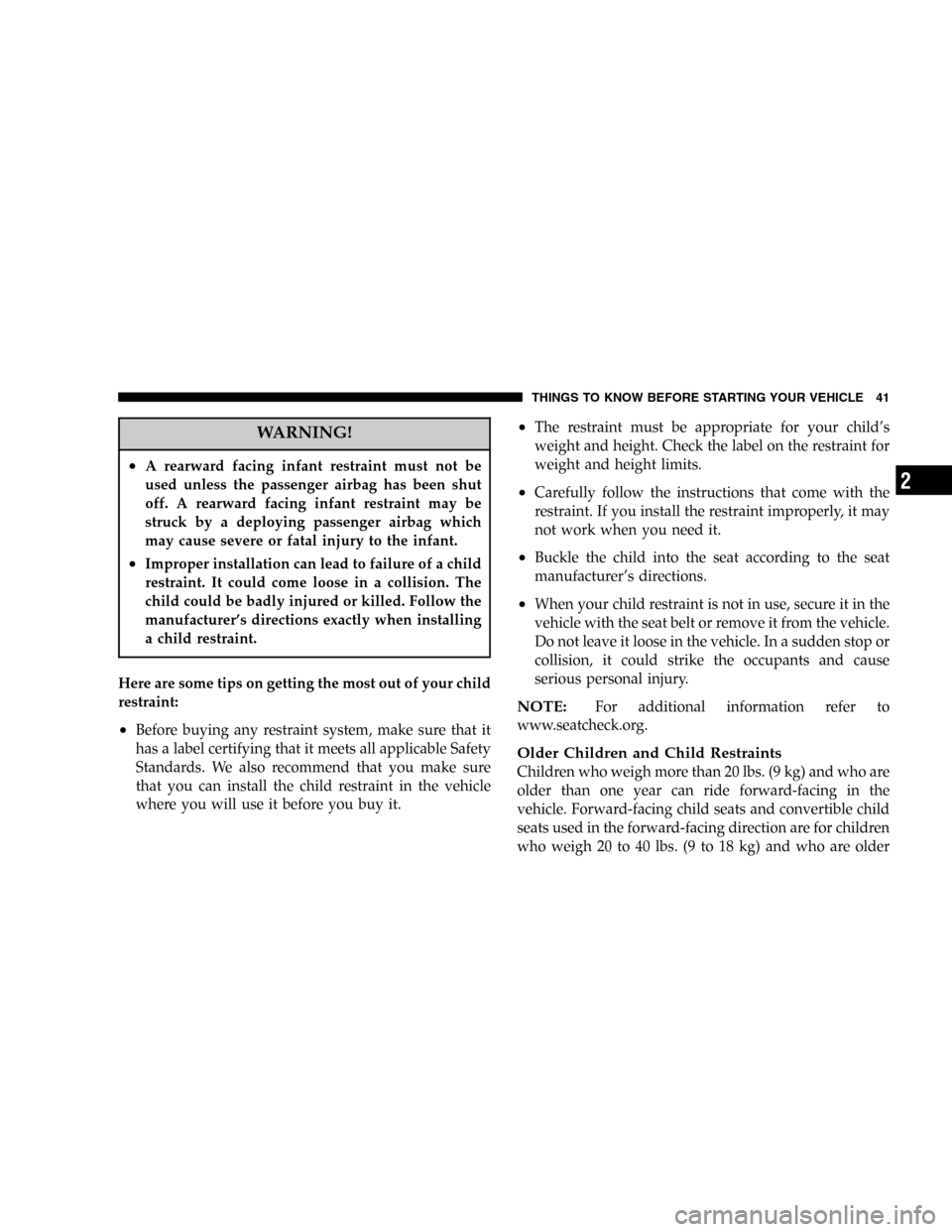2005 CHRYSLER CROSSFIRE SRT airbag off
[x] Cancel search: airbag offPage 30 of 280

The seat belts are designed to protect you in many types
of collisions. The front airbags deploy only in moderate
to severe front collisions. In certain types of collisions,
both the front and side airbags may be triggered. But
even in collisions where the airbags work, you need the
seat belts to keep you in the right position for the airbags
to protect you properly.
Here are some simple steps you can take to minimize
the risk of harm from a deploying airbag.
1. Infants in rear-facing child safety seats shouldNEVER
ride in the front seat of a vehicle with a passenger frontal
airbag unless the airbag is shut OFF. See“Passenger
Airbag On/Off Switch”and“To Shut Off the Passenger
Airbag.”The rear-facing seat places them too close to the
passenger air bag in the event of a crash. An airbag
deployment can cause severe injury or death to infants in
this position.
Children that are not big enough to properly wear the
vehicle seat belt (see section on“Child Restraint”) should
be secured in child safety seats or booster seats that are
appropriate for the child’s age, height, and weight.Older children who do not use child safety seats or
booster seats should ride properly buckled. Never allow
children to place the shoulder belt behind them or under
the arm.
If a child from 1 to 12 years old must ride in the vehicle,
move the seat as far back as possible, shut off the
passenger airbag, and use the proper child restraint. See
the section on“Child Restraint.”
You should read the instructions provided with your
child restraint or belt-positioning booster seat to make
sure that you are using it properly.
2. All occupants should wear their lap and shoulder belts
properly.
3. The driver and passenger seats should be moved back
as far as practical to allow the front airbags room to
inflate.
4. Do not lean against the door, as the side airbags will
inflate forcefully into the space between you and the
door. (See the section on“Side Airbags.”)
30 THINGS TO KNOW BEFORE STARTING YOUR VEHICLE
Page 31 of 280

WARNING!
•Relying on the airbags alone could lead to more
severe injuries in a collision. The airbags work
with your seat belt to restrain you properly. In
some collisions the airbags won’t deploy at all.
Always wear your seat belts even though you
have airbags.
•Being too close to the steering wheel or instru-
ment panel during airbag deployment could cause
serious injury.
•Airbags need room to inflate. Sit back, comfort-
ably extending your arms to reach the steering
wheel or instrument panel.
•The side airbags also need room to inflate. Do not
lean against the door. Sit upright in the center of
the seat.
Airbag System Components
The airbag system consists of the following:
•Airbag control module and internal crash sensor
•AIRBAG readiness light
•Driver and passenger frontal airbag/inflator units
•Driver and passenger side airbag/inflator units
•Passenger airbag On/Off switch and indicator light
•Unique steering wheel and column
•Unique instrument panel
•Interconnecting wiring
•Knee impact bolster
•Side impact sensors
How the Front Airbag System Works
•
A crash sensor in the occupant compartment deter-
mines if a frontal impact is severe enough to require
the airbag. The sensor will not detect side, roll over, or
rear impacts. The sensor is connected to the diagnostic
unit and to the airbag/inflator unit.
•The Occupant Restraint Controller monitors the readi-
ness of the electronic parts of the system whenever the
ignition switch is in the START or ON/RUN positions.
THINGS TO KNOW BEFORE STARTING YOUR VEHICLE 31
2
Page 32 of 280

These include all of the items listed above except the
knee bolster, the instrument panel, and the steering
wheel and column.
•The Occupant Restraint Controller also turns on the
AIRBAG light in the instrument panel for four seconds
when the ignition is first turned on, then turns the
light off. If it detects a malfunction in any part of the
system, it turns on the light either momentarily or
continuously depending on the condition that is
present at the time.
•The airbag/inflator units are in the center of the
steering wheel and in the instrument panel. The words
SRS/AIRBAG are embossed on the airbag covers.
WARNING!
Ignoring the AIRBAG light in your instrument panel
could mean you won’t have the airbags to protect
you in a collision. If the light does not come on, stays
on after you start the vehicle, or if it comes on as you
drive, have the airbag system checked right away.
WARNING!
Do not put anything on or around the airbag covers
or attempt to manually open them. You may damage
the airbags and you could be injured because the
airbags are not there to protect you. These protective
covers are designed to open only when the airbags
are inflated.
•When the crash sensor detects an impact requiring the
airbags, it signals the inflator units. A large quantity of
nontoxic nitrogen gas is generated to inflate the air-
bags. The airbag covers separate and fold out of the
way as the airbags inflate to their full size. The airbags
then quickly deflate while helping to restrain the
driver and passenger. The airbag gas is vented
through the airbag material towards the instrument
panel. In this way the airbags do not interfere with
your control of the vehicle.
32 THINGS TO KNOW BEFORE STARTING YOUR VEHICLE
Page 36 of 280

WARNING!
•The door mounted side airbag deploys with con-
siderable force. Being too close to the door panel
during airbag deployment could cause serious
injury or death.
•All occupants must be in the appropriate restraint
for their size and age, especially children 12 and
under.
•To help avoid the potential for serious injury and
death should the side airbag be activated, please
follow these guidelines:
1. Occupants, especially children, should never lean
against the door in the area where the side airbag
inflates;
2. Occupants need to sit upright in the center of the
seat to give the side airbag room to inflate;
3. Always use the appropriate restraint for the occu-
pant and ensure it is properly used.
Passenger Front Airbag On/Off Switch
The on/off switch is located at the right end of the
instrument panel and is accessible by opening the pas-
senger door.
The on/off switch is to be used only when the passenger
is:
•an infant (less than 1 year old),
•a child, age 1 to 12,
•an adult with a medical condition which makes pas-
senger airbag inflation (deployment) a greater risk for
the passenger than the risk of hitting the dashboard
(instrument panel) or windshield in a crash.
36 THINGS TO KNOW BEFORE STARTING YOUR VEHICLE
Page 37 of 280

If the airbag is turned off when there is any other
occupant at that position, the supplemental restraint
provided by the airbag will not be available.
To turn OFF the passenger front airbag, use the on/off
switch located on the instrument panel.NOTE:When the passenger airbag is turned off, the
yellow airbag off light will illuminate.
THINGS TO KNOW BEFORE STARTING YOUR VEHICLE 37
2
Page 38 of 280

To Shut Off the Passenger Airbag:
•Place the ignition key in the on/off switch, turn the
key clockwise, and remove the key from the switch.
This will shut off the passenger front airbag.
•The air bag will remain off until the switch is turned
back to the ON position.
•The switch does NOT turn off the side airbag.To Turn On the Passenger Airbag:
•Place the ignition key in the on/off switch, turn the
key counterclockwise, and remove the key from the
switch. This will turn on the passenger airbag. The
Passenger Airbag Off light on the console will turn off,
or will not be illuminated when the ignition is turned
to the ON position.
WARNING!
The airbag may malfunction and serious injury
could result if key is left in the airbag shut off
switch. Always remove the key.
38 THINGS TO KNOW BEFORE STARTING YOUR VEHICLE
Page 40 of 280

WARNING!
In a collision, an unrestrained child, even a tiny
baby, can become a missile inside the vehicle. The
force required to hold even an infant on your lap
could become so great that you could not hold the
child, no matter how strong you are. The child and
others could be badly injured. Any child riding in
your vehicle should be in a proper restraint for the
child’s size.
Infants and Child Restraints
There are different sizes and types of restraints for
children from newborn size to the child almost large
enough for an adult safety belt. Always check the child
seat Owner’s Manual to ensure you have the right seat
for your child. Use the restraint that is correct for your
child:
•Safety experts recommend that children ride
rearward-facing in the vehicle until they are at least
one year old and weigh at least 9 kg (20 lbs.). Twotypes of child restraints can be used rearward-facing:
infant carriers and“convertible”child seats.
•The infant carrier is only used rearward-facing in the
vehicle. It is recommended for children who weigh up
to about 20 lbs. (9 kg).“Convertible”child seats can be
used either rearward-facing or forward-facing in the
vehicle. Convertible child seats often have a higher
weight limit in the rearward-facing direction than
infant carriers do, so they can be used rearward-facing
by children who weigh more than 20 lbs. (9 kg) but are
less than one year old. Both types of child restraints are
held in the vehicle by the lap/shoulder belt or the
LATCH child restraint anchorage system. (See the
LATCH - Child Seat Anchorage System section.)
•Rearward-facing child seats mustNEVERbe used in
the front seat of a vehicle with the front passenger
airbag unless the airbag is turned off. An airbag
deployment could cause severe injury or death to
infants in this position.
40 THINGS TO KNOW BEFORE STARTING YOUR VEHICLE
Page 41 of 280

WARNING!
•A rearward facing infant restraint must not be
used unless the passenger airbag has been shut
off. A rearward facing infant restraint may be
struck by a deploying passenger airbag which
may cause severe or fatal injury to the infant.
•Improper installation can lead to failure of a child
restraint. It could come loose in a collision. The
child could be badly injured or killed. Follow the
manufacturer’s directions exactly when installing
a child restraint.
Here are some tips on getting the most out of your child
restraint:
•Before buying any restraint system, make sure that it
has a label certifying that it meets all applicable Safety
Standards. We also recommend that you make sure
that you can install the child restraint in the vehicle
where you will use it before you buy it.
•The restraint must be appropriate for your child’s
weight and height. Check the label on the restraint for
weight and height limits.
•Carefully follow the instructions that come with the
restraint. If you install the restraint improperly, it may
not work when you need it.
•Buckle the child into the seat according to the seat
manufacturer’s directions.
•When your child restraint is not in use, secure it in the
vehicle with the seat belt or remove it from the vehicle.
Do not leave it loose in the vehicle. In a sudden stop or
collision, it could strike the occupants and cause
serious personal injury.
NOTE:For additional information refer to
www.seatcheck.org.
Older Children and Child Restraints
Children who weigh more than 20 lbs. (9 kg) and who are
older than one year can ride forward-facing in the
vehicle. Forward-facing child seats and convertible child
seats used in the forward-facing direction are for children
who weigh 20 to 40 lbs. (9 to 18 kg) and who are older
THINGS TO KNOW BEFORE STARTING YOUR VEHICLE 41
2